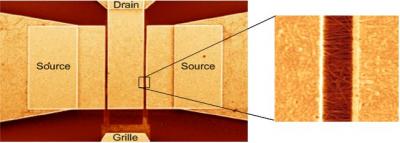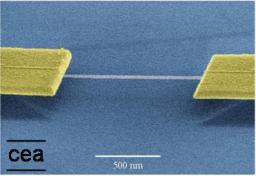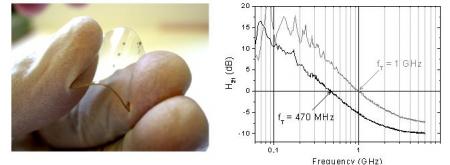

Scanning electron miscroscopy image of a high frequency operating carbon nanotube transistor. The detail shows the parallel nanotubes in the transistor channel.
Carbon nanotube based HF transistors
Thanks to their exceptional electronic properties, carbon nanotubes are a particularly well suited material for high frequency devices. Numerous predictions foresee that the cut off frequency of optimized carbon nanotube transistors would surpass classical semiconductor transistors. However, experimental realizations are scarce because the high impedance of single nanotubes (>10k Ohm) is not adapted to standard HF instruments (50 Ohms adapted). Besides, the carbon nanotube part of the complete device is usually very small, so that the noise issued from the rest of the device is usually overwhelming.
In collaboration with Gilles Dambrine’s team at IEMN (CNRS Lille), we built low impedance carbon nanotubes transistors constituted of a dense network of aligned nanotubes. Cut off frequencies above 10GHz have been obtained, which is the highest cut off frequency to date for carbon nanotube devices.
In addition, our transistors can be advantageously built on nearly any substrate, in particular on flexible organic substrates. We have demonstrated a flexible carbon nanotube transistor with a cut off frequency of 1GHz. We therefore showed that carbon nanotubes are serious candidates for the development of flexible, fast electronics, in a frequency regime inaccessible to conventional organic materials.

Scanning electron miscroscope image of a nanoelectromechanical device constituted of a carbon nanotube suspended between two gold electrodes.
Electromechanical properties of carbon nanotubes
Carbon nanotubes, especially multiwall carbon nanotubes, are promising nanomaterials in the design of nano-electromechanical devices (NEMS). Such developments rely on the fine understanding of the interdependent parameters of the nanotube: mechanical (Young’s modulus), electrical (conductivity, voltages) and geometrical (diameter, length, suspension height above control electrode) characteristics. Our laboratory demonstrated in particular that all these parameters could be related by a theoretical scaling law. This law has been experimentally verified by direct measurements of the electrostatic deflection of individual carbon nanotubes. Our study could also determine with a good accuracy the Young modulus of individual nanotubes. Besides, our laboratory demsontrated that a single suspended multiwall carbon nanotube could be built into an electromechanical switch of notably high performance.
•  Future optics and electronics › Organic and molecular electronics
Future optics and electronics › Organic and molecular electronics












